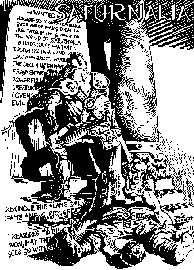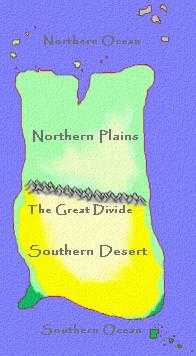Saturnalia (PBM)

Saturnalia was one of the first single-character sword and sorcery fantasy Play-by-Mail role-playing games run in the United Kingdom. The game started in 1984, being created by Neil Packer and Simon Letts and grew from its initial players at the University of Southampton up to over three thousand scattered across the United Kingdom and beyond. A company, Sloth Enterprises was formed, with many full-time GMs running Saturnalia from offices above a tyre/brakes/exhaust garage in the red-light district of Southampton.
In time, the company gradually faded away, with several former players taking on the role of GM to run either existing campaigns or to open up new areas. Most of these successors ran through the early 2000s (decade), and the Harlequin Games Exile campaign in the Southern Isles remains active.
The game was named for the Roman festival of Saturnalia, in that making the game, forming the rules and applying for the Enterprise Allowance Scheme, was total chaos. The word "Saturnalia" was one which turned up under the entry for "Chaos" in a thesaurus. Players took on the roles of adventurers. The game started on two sets of islands off the North and South coast of the continent, Erythria. This was named for no reason better than it sounded good. The Northern Isles included Faldeheim, Jorleheim and Tafkhim. The Southern Isles were Alagas, Krang and Ghan.
Importance
Saturnalia was one of the first and certainly one of the largest PBM games run in the United Kingdom. It inspired numerous other games and was important in the initiation of game pub-meets. The game has, in various forms, remained in existence for since 1984.
Whilst there is no direct link between Saturnalia and online role-playing games, PBM games were their early forerunners. If it were not for PBM games showing the way, there would be no online role-playing games.
Game Mechanics
Campaign Regions
The campaign regions of Erythria have included:
- Central - Narquoron
- Distant Isles.
- North East Erythria.
- North West Erythria.
- Northern Isles
- Serpent Isles.
- South Erythria.
- Southern Isles.
- Exile. The last remaining active region.
At one time in the late 1980s the campaign regions were designated by colour:
- Central/Narquoron (Pink)
- North East Erythria (Red)
- Northern Isles (White)
- Southern Isles (Blue)
- South Erythria (Yellow)
Character Statistics
Characters were defined by the following statistics:
- Combat Ability (CA).
- Magic Points (MP).
- Stealth and Agility (SA).
- Perception (PER).
- Vitality (VIT).
On initial start-up in the game, a player had 250 points to allocate between these statistics, with none given less than twenty points and none more than a hundred.
Each turn, the Games Master would award the player bonus points to be allocated between these statistics. Points could also be lost (in most games) by injury or by using MP to cast magical spells. Bonus points would be awarded depending on how well a character performed during a turn, but also on how well the player wrote the instructions. This could be entirely subjective and at the whim of the GM.
A character would begin as a very lowly adventurer, gaining in ability as points were added to their statistics. Their actions in the game would result in gaining renown as Fame and Infamy; the former would be awarded for positive actions and the latter for negative actions. These defined the character as Good or Evil, with an accumulation of major good or evil acts required to gain a double figure Fame or Infamy. This was the Saturnalia equivalent of Dungeons & Dragons Alignment.
To prevent character death resulting in the loss of a player, Saturnalia included a Karma system so that in the unfortunate event of a character dying, the player could create a new character using the standard number of points, plus a bonus derived from their dead character's points, Fame and Infamy. This meant that the paying player did not lose their entire investment in playing the game. Saturnalia was the first single character RPG and the Karma system was a way of ensuring that players who lost their character did not lose everything they had invested.
Setting
The game was set on and around Erythria, a massive continent approximately two thousand miles east-west and four thousand north-south, plus the island chains to the north and south. Different regions of the continent and surrounding islands were divided between different Games Masters, with geographical features separating the various regions. This permitted Saturnalia to become one of the earliest shared world building fantasy campaigns utilising a common framework of in-game religions and early history, whilst permitting the different regions to co-exist with minimal cross-campaign interference. Player characters could, under exceptional circumstances move from one campaign region to another, but only with great persistence and luck, or with the agreement of the relevant Games Masters.
Geography

The major geographical features of Erythria included:
- The Northern Ocean – A scattering of islands including:
- The Serpent Isles, a small chain comprising four main islands: Bromo, Formo, Trefato and Sepakak.
- The Northern Isles in arctic waters including Jorleheim, dominated by fierce clans, Faldeheim, dominated by Royalists, and Tafkhim, an isle of city states.
- The Northern Plains – Extending across the entire northern portion of the continent, ranging from near featureless grasslands to stretches of arid desert or steppe.
- The Great Divide - A monstrous range of mountains splitting Erythria into north and south, and impossible to cross. Compared with this mountain chain the rare hills and mountains of the Northern Plains were mere ridges.
- The Great River – A gigantic river system flowing northwards from the Great Divide towards the Northern ocean splitting the northern extent of the continent into the campaign regions of the North East and North West. The Great River at places was more than a hundred miles wide.
- The Southern Desert – A vast desert below the southern edge of the Great Divide. Away from the centre the land became more fertile with forests on the eastern and western coasts and jungle further south.
- The Southern Ocean – including the tropical Southern Isles, an archipelago of sixty islands including Alagas, Ghan and Krang.
History
The recorded history of Erthyria begins with the invasion of the Northmen of the Northern Isles, with their greatest leader being Erik the Forger. Their tide of conquest swept over the continent, clashing with the native tribes and defeating the nomads of the Great Plains, breaking the power of the Ocean King, the overlord of the tribes of the sea of grass. Reaching the Great Divide, the Northmen extended their conquest by sea, ultimately dominating the entire continent and uniting it under the rule of the Empire. In the far south the Northmen conquered the civilised Sahmen worshipping Mordish, driving them to the southern coast of Erythyria and across the ocean to the Southern Isles.
Erik and his descendants were so pivotal to the history of Erythria that his name was used in the dating system: AE, After Erik.
In time the Empire fragmented, and the resurgent nomads broke many of the successor states dotted across the Northern Plains, until all that remained were isolated city states, mostly on the coast. In the south the Empire endured until it too was smashed by wars with the desert nomads.
After the fall of the Empire in the north, for a time the banner of the Ocean King was uncontested, but after leaving the inland cities as ruins his domain dissolved into many different tribes, awaiting the raising of his standard again. The remaining cities dwindled into fractious city-states, often pursuing religious conflicts between themselves.
Campaign Dating
The game dating system was derived from AE 901 in 1984, and incremented annually, so 2009 relates to AE 925.
Common Themes
One of the common themes shared by the different regional campaigns was the quest for the fourteen swords of power, each dedicated to a deity of the Saturnalia game world.
These swords had been created by dwarven master runesmiths during the second century of the expansion of Erik's Empire. The swords served as the motive for quests and struggles between the player character heroes attempting to become a champion of one of the gods. Other, less powerful magical weapons appeared across the campaigns.
Currency
All of the Saturnalia games used a common currency. The whole currency system was based around the crucial facts that:
- The gold cadoc. A cadoc was worth ten phymeres.
- The silver phymere. A phymere was worth ten ogrods.
- The bronze ogrod. Ogrods were many, Cadocs were few.
Pantheon
The Saturnalia campaigns shared a common pantheon:
- Corgul: God of Law.
- Destu: God of Darkness.
- Dianodus: God of Balance.
- Drasci: Thief God.
- Egar-Colmetch: God of Wealth.
- Haquar: Goddess of Magic.
- Morana: Life Goddess.
- Orth: War God.
- Renchu: Death God.
- Sahmen: Sun God.
- Somol: Weather God.
- Suocona: Love Goddess.
- Trolin: Healing Goddess.
- Trorindar: Moon Goddess.
Sources
- Saturnalia rulebook.
- Flagship magazine reviews.